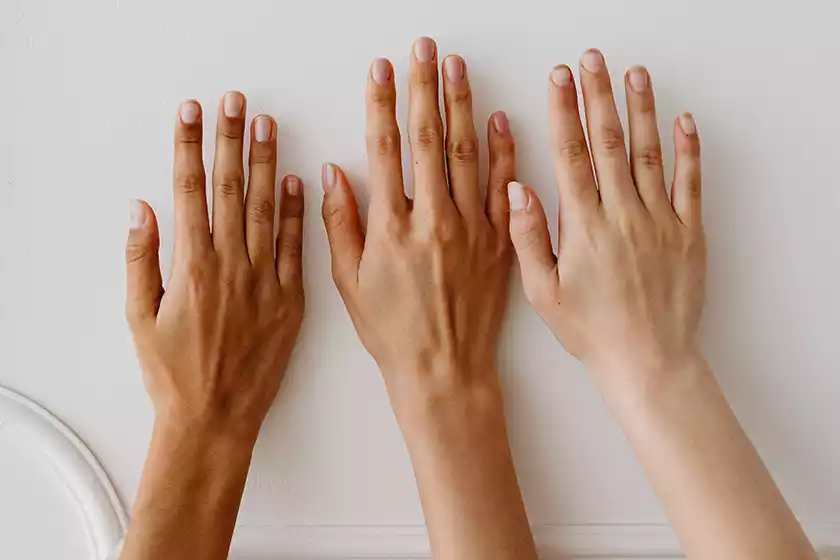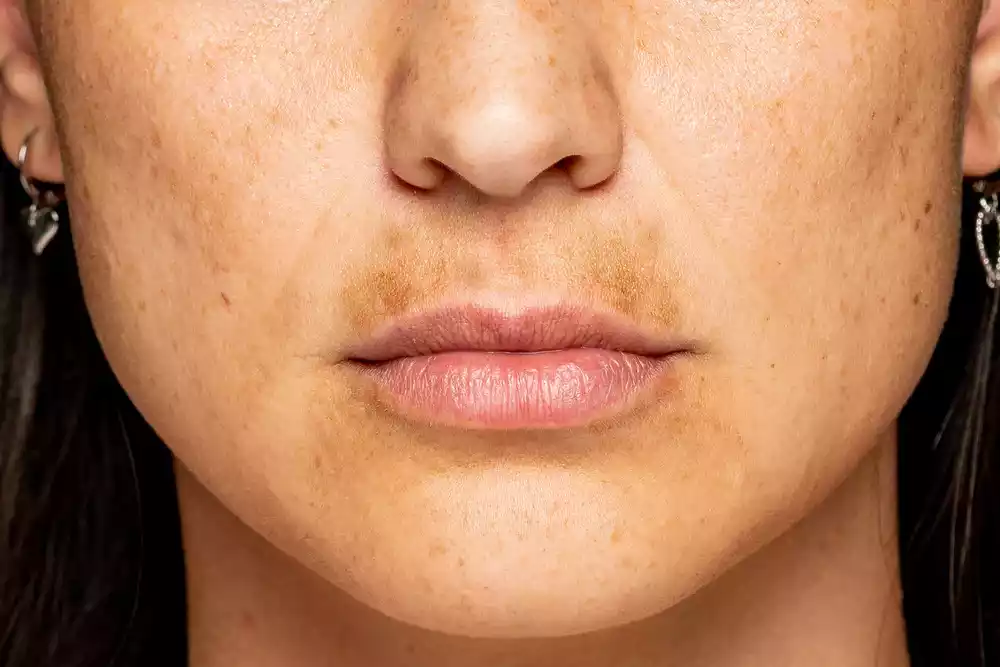Skin Tone and Undertone are essential factors in the world of beauty and fashion. Your skin tone is the general color of your skin, while your undertone is the subtle hue beneath the surface. Understanding these aspects helps you choose the right makeup, clothing, and even hair color to enhance your natural beauty. We will delve deeper into these concepts and provide you with valuable insights to make informed choices about your beauty routine.
What is Skin Tone?
Skin tone refers to the natural color or shade of an individual’s skin, resulting from the pigmentation levels in their skin, primarily determined by the amount of melanin present. Skin tones can vary widely among individuals and are typically categorized into general groups, such as fair, light, medium, dark, or deep, to describe the overall coloration of a person’s complexion.

Understanding your skin tone is essential in various contexts, including selecting suitable makeup products, choosing clothing colors that complement your complexion, and making informed skincare decisions.
The Fitzpatrick Scale
The Fitzpatrick Scale, developed in 1975 by American dermatologist Thomas B. Fitzpatrick, is a classification system used to categorize human skin types based on their response to UV (ultraviolet) radiation. This scale helps in assessing how different skin types are likely to react to sun exposure and is commonly used in dermatology and skincare to determine appropriate treatments and sun protection measures.
The Fitzpatrick Scale consists of six skin type categories, ranging from Type I to Type VI, and is determined by various factors such as skin color, susceptibility to sunburn, and the tendency to tan.
Here’s an overview of each skin type on the Fitzpatrick Scale:
- Type I (Very Pale Skin):
- Skin Color: Pale white.
- Sun Reaction: Always burns, never tans.
- Characteristics: Typically has freckles and a high risk of skin damage from sun exposure.
- Type II (Fair Skin):
- Skin Color: Fair or light.
- Sun Reaction: Burns easily, tans minimally.
- Characteristics: May have freckles and usually requires sun protection.
- Type III (Light to Medium Skin):
- Skin Color: Fair to beige.
- Sun Reaction: Burns moderately, tans gradually.
- Characteristics: Tans more easily than Types I and II but still needs sun protection.
- Type IV (Olive to Light Brown Skin):
- Skin Color: Light brown to olive.
- Sun Reaction: Burns minimally, tans easily.
- Characteristics: Often has Mediterranean or Asian ancestry and can tolerate moderate sun exposure.
- Type V (Medium to Dark Brown Skin):
- Skin Color: Dark brown.
- Sun Reaction: Rarely burns, tans easily and substantially.
- Characteristics: Common among people with African, Hispanic, or Indian ancestry.
- Type VI (Very Dark Skin):
- Skin Color: Deeply pigmented brown to black.
- Sun Reaction: Almost never burns, deeply pigmented.
- Characteristics: Common among individuals of African descent.
Understanding one’s Fitzpatrick skin type is valuable for determining the appropriate level of sun protection, skincare products, and cosmetic procedures tailored to individual skin needs. It also aids in the prevention of skin disorders like sunburn, premature aging, and skin cancer.
Determining Your Skin Tone
Determining your skin tone is essential for choosing makeup shades, clothing colors, and even hair colors that complement your complexion. Here are some methods to help you identify your skin tone:
- Natural Light Test:
- Find a well-lit area with natural daylight.
- Stand in front of a mirror and hold a piece of white paper next to your face.
- Observe how your skin appears in contrast to the white paper.
- Cool undertones: Your skin will appear slightly pink or bluish.
- Warm undertones: Skin colors could include peach, yellow or golden hues.
- Neutral undertones: Your skin will neither appear too pink nor too yellow.
- Vein Test:
- Check the veins along the outside of your wrist in natural light.
- Cool undertones: If your veins appear blueish or purple, this could indicate that you possess cool undertones.
- Warm undertones: Greenish veins indicate warm undertones.
- Neutral undertones: If it’s challenging to determine whether your veins are blue or green, you may have neutral undertones.
- Jewelry Test:
- Consider which type of jewelry complements your skin better.
- Cool undertones: Silver or white gold jewelry tends to flatter cool undertones.
- Warm undertones: Gold or rose gold jewelry often complements warm undertones.
- Neutral undertones: You may find both silver and gold jewelry look good on you.
- Observational Method:
- Stand in front of a mirror in natural light.
- Hold up different colored fabrics or clothing near your face.
- Pay attention to which colors make your complexion appear more vibrant and healthy.
- Cool undertones: Colors like blues, purples, and cool-toned pinks may be flattering.
- Warm undertones: Earthy tones, oranges, warm reds, and yellows may enhance your appearance.
- Consult a Professional:
- If you’re uncertain about your skin tone or undertone, consider seeking the advice of a makeup artist or a beauty consultant at a cosmetics store.
- They can perform color analysis and provide personalized recommendations.
Remember that while these methods can help you identify your skin tone, individuals may have a mix of undertones or unique characteristics. Additionally, skin tone can change slightly due to factors like sun exposure or health. Therefore, it’s essential to periodically reassess your skin tone for the most accurate results.
What is Undertone?
Undertone refers to the subtle, underlying hues or undertones present beneath the surface of an individual’s skin. These undertones are not immediately apparent but play a significant role in determining how certain colors or cosmetics appear against the skin. Undertones can generally be divided into three categories: cool, warm and neutral.

Warm undertones have hints of yellow, peach, or golden hues, cool undertones feature pink, blue, or red undertones, and neutral undertones exhibit a balanced mixture of warm and cool hues. Understanding your undertone is essential when selecting makeup, clothing, and hair colors that harmonize with your natural skin tone, enhancing your overall appearance.
Warm Undertones
Warm undertones refer to the subtle hues beneath the surface of your skin that have warm, yellow, peachy, or golden tones. Identifying warm undertones in your complexion is essential for choosing makeup shades, clothing colors, and hair colors that complement your skin’s natural warmth.
Here are some characteristics and color recommendations for individuals with warm undertones:
Characteristics of Warm Undertones:
- Veins: If you look at the veins on the inside of your wrist under natural light, they tend to appear more greenish than blue.
- Sun Reaction: You may tan easily and rarely burn when exposed to the sun.
- Skin Color: Your skin may have a golden or peachy undertone, with hints of yellow or warm beige.
- Hair Color: Natural hair colors for warm undertones often include shades of brown with golden or red highlights, strawberry blonde, auburn, and golden blonde.
Colors That Complement Warm Undertones:
- Clothing: Warm undertones are flattered by earthy tones like terracotta, camel, olive green, and warm shades of red and orange.
- Makeup: For foundation and concealer, look for shades labeled as “warm” or “golden.” Warm undertones also pair well with warm-toned blushes and lip colors in coral, peach, and warm reds.
- Jewelry: Gold or rose gold jewelry tends to enhance the warmth in your skin.
Individuals with warm undertones may vary in their exact shade and intensity. When choosing colors, consider your specific undertone and how it complements your overall complexion to create a harmonious and flattering look.
Cool Undertones
Cool undertones refer to the subtle hues beneath the surface of your skin that have cool, pink, blue, or purplish tones. Identifying cool undertones in your complexion is crucial for choosing makeup shades, clothing colors, and hair colors that complement your skin’s natural coolness.
Here are some characteristics and color recommendations for individuals with cool undertones:
Characteristics of Cool Undertones:
- Veins: When you look at the veins on the inside of your wrist under natural light, they tend to appear bluish or even purplish.
- Sun Reaction: You may burn more easily when exposed to the sun and may not tan as quickly or deeply as those with warm undertones.
- Skin Color: Your skin may have a pinkish or bluish undertone, with cool beige or porcelain tones.
- Hair Color: Natural hair colors for cool undertones often include shades of brown with ashy or cool undertones, ash blonde, cool-toned black, or silver.
Colors That Complement Cool Undertones:
- Clothing: Cool undertones are flattered by cool and jewel-toned colors like navy blue, royal blue, emerald green, lavender, and cool shades of pink and purple.
- Makeup: For foundation and concealer, look for shades labeled as “cool” or “rosy.” Cool undertones also pair well with cool-toned blushes and lip colors in rosy pinks and berry shades.
- Jewelry: Silver or white gold jewelry tends to enhance the coolness in your skin.
Remember that individual variations can exist within cool undertones, so it’s essential to consider your specific undertone and how it complements your overall complexion when selecting colors for a flattering and harmonious look.
Neutral Undertones
Neutral undertones refer to the subtle hues beneath the surface of your skin that are neither distinctly warm (yellow, peach, or golden) nor cool (pink, blue, or purplish). Identifying neutral undertones in your complexion is important for choosing makeup shades, clothing colors, and hair colors that work well with the balanced undertones of your skin.
Here are some characteristics and color recommendations for individuals with neutral undertones:
Characteristics of Neutral Undertones:
- Veins: The veins on the inside of your wrist may appear bluish-green or a combination of both blue and green, indicating a balance between warm and cool undertones.
- Sun Reaction: You may have a moderate tendency to burn or tan, falling between the extreme reactions of warm and cool undertones.
- Skin Color: Your skin may have a mix of warm and cool undertones, resulting in a neutral beige, olive, or tan complexion.
- Hair Color: Natural hair colors for neutral undertones can vary widely and may include shades of brown, blonde, or black with a balanced undertone.
Colors That Complement Neutral Undertones:
- Clothing: Neutral undertones provide versatility and can wear a wide range of colors comfortably. Earthy tones, pastels, and jewel tones often look flattering on neutral undertones.
- Makeup: Look for foundation and concealer shades labeled as “neutral” or “balanced.” Neutral undertones can experiment with a variety of makeup colors, from warm to cool, to find what suits them best.
- Jewelry: Both silver and gold jewelry can complement neutral undertones since they don’t overpower the skin’s natural balance.
Individual variations can still exist within neutral undertones, so it’s essential to consider your unique undertone and how it interacts with your overall complexion when choosing colors for a harmonious and flattering appearance.
Comparison Table of Skin Tone and Undertone
Here’s a comparison table of skin tone and undertone to highlight the key differences between these two aspects:
| Aspect | Skin Tone | Undertone |
|---|---|---|
| Definition | The natural color of the skin’s surface, influenced by melanin levels and environmental factors. | Subtle hues beneath the skin’s surface, affecting how colors appear against the skin. Categorized as warm, cool, or neutral. |
| Categorization | Typically categorized as fair, light, medium, dark, or deep. | Categorized as warm, cool, or neutral. |
| Determining Factors | Melanin levels, sun exposure, age, and genetics. | Undertone is influenced by the color of blood vessels and surface pigments. |
| Identification | Can be determined by observing the skin’s overall coloration. | Determined through tests like the vein test, jewelry test, or white paper test. |
| Makeup Selection | Important for choosing the right foundation shade. | Critical for selecting makeup products that complement the undertone, avoiding mismatched makeup. |
| Clothing Choices | Can influence which clothing colors enhance one’s appearance. | Helps in choosing clothing colors that harmonize with the undertone, making outfits more flattering. |
| Overall Impact | Determines the surface color of the skin. | Affects how makeup, clothing, and hair colors interact with the skin, influencing the overall look. |
Understanding both your skin tone and undertone is crucial for making informed decisions in fashion and beauty, ensuring that colors and products chosen complement your unique complexion effectively.
Why Does It Matter?
Understanding your skin tone and undertone matters for several reasons:
- Flattering Appearance: Knowing your skin tone and undertone helps you select makeup, clothing, and hair colors that enhance your natural beauty. Wearing colors that complement your undertones can make your complexion appear more vibrant, healthy, and radiant.
- Avoiding Mismatched Makeup: Choosing the right foundation, concealer, and other makeup products that match your skin’s undertone prevents makeup from looking too ashy, orange, or unnatural against your skin.
- Sun Protection: Your skin’s natural sun reaction, influenced by your skin tone, determines how easily you burn and tan. This knowledge is crucial for selecting the appropriate level of sun protection to prevent sunburn and reduce the risk of skin damage and skin cancer.
- Confidence and Self-Expression: When you look and feel good in your skin, it boosts your confidence and allows you to express your personal style authentically. You can experiment with different colors and styles that suit your undertones.
- Wardrobe Coordination: Understanding your undertones helps you build a wardrobe with clothing colors that harmonize with your complexion. This simplifies the process of mixing and matching outfits and ensures that your clothing complements your skin tone.
- Skincare Choices: Knowing your skin’s undertone can guide you in selecting skincare products, including cleansers, moisturizers, and foundations, that cater to your specific needs. Some products are formulated to address concerns related to warm, cool, or neutral undertones.
- Avoiding Makeup Mishaps: By understanding your undertones, you can prevent common makeup mistakes like foundation lines, mismatched lip colors, or blush shades that clash with your skin’s natural hues.
- Personalized Beauty and Grooming: Tailoring your beauty and grooming routine to your undertones ensures a more polished and put-together appearance. This can be especially important for special occasions, professional settings, or when you want to make a lasting impression.
Knowing your skin tone and undertone empowers you to make informed choices in various aspects of your beauty and fashion routine, leading to a more confident, polished, and flattering overall look. It allows you to embrace and celebrate your unique features while making the most of them.
Choosing the Right Foundation
Choosing the right foundation involves:
- Identifying your skin tone (fair, light, medium, dark, deep).
- Determining your undertone (warm, cool, neutral).
- Selecting the right formula based on your skin type.
- Matching your foundation shade to your skin tone and undertone.
- Testing shades in natural light.
- Considering seasonal changes.
- Checking wear time and finish.
- Testing for allergies and sensitivities.
- Blending well for a flawless look. Remember that it may require some trial and error to find your perfect match.
Common Mistakes to Avoid
When it comes to choosing and applying foundation, there are several common mistakes that people often make. Avoiding these mistakes can help you achieve a flawless and natural-looking complexion.
Here are some common errors to watch out for:
- Choosing the Wrong Shade:
- One of the most common mistakes is selecting a foundation shade that doesn’t match your skin tone or undertone. This can result in a noticeable line of demarcation between your face and neck.
- Testing in the Wrong Lighting:
- Testing foundation indoors under artificial lighting can be misleading. Always swatch and assess shades in natural light to ensure an accurate match.
- Skipping Primer:
- Not using a primer can lead to uneven application and reduced longevity of your foundation. Primer helps create a smooth canvas for makeup and can improve its staying power.
- Applying Too Much Product:
- Applying a heavy layer of foundation can make your skin look cakey and unnatural. Start small, and increase the coverage as necessary.
- Ignoring Your Skin Type:
- Using the wrong foundation formula for your skin type can lead to issues like excessive shine, dryness, or clogged pores. Choose a formula tailored to your specific skin needs.
- Neglecting to Blend:
- Failing to blend foundation properly, especially along the jawline and hairline, can result in a noticeable contrast between your face and the rest of your skin.
- Not Considering Seasonal Changes:
- Your skin tone can change slightly with the seasons, so it’s important to adjust your foundation shade accordingly.
- Overlooking Undertone:
- Not taking your undertone into account can lead to a foundation that clashes with your skin’s natural warmth or coolness. Make sure to match both your skin tone and undertone.
- Testing on the Wrong Area:
- Some people swatch foundation on their wrists or hands, which may not be the same color as your face. Always test on your jawline or the side of your face.
- Using the Wrong Tools:
- The tools you use to apply foundation can affect the finish. Brushes, sponges, and fingers can provide different results, so choose the one that works best for you.
- Applying Foundation Before Skincare Products Dry:
- Applying foundation immediately after skincare products can cause it to slide or pill. Allow your skincare to absorb fully before applying makeup.
- Not Setting Your Foundation:
- For longer-lasting makeup, consider setting your foundation with a translucent powder to reduce shine and lock in your look.
- Not Checking Ingredients:
- If you have sensitive or acne-prone skin, be sure to check the ingredients list for potential irritants or comedogenic substances in your foundation.
By avoiding these common mistakes and taking the time to select and apply foundation carefully, you can achieve a more natural and flawless finish that enhances your natural beauty.
Conclusion
Understanding your skin tone and undertone is essential for making informed choices in makeup, clothing, and skincare. It empowers you to select colors and products that complement your complexion, enhancing your natural beauty and confidence.
Whether you have warm, cool, or neutral undertones, embracing and celebrating your unique features allows you to express your personal style authentically while avoiding common beauty and fashion mishaps. By taking the time to identify your skin tone and undertone, you can achieve a harmonious and flattering look that reflects your individuality.































